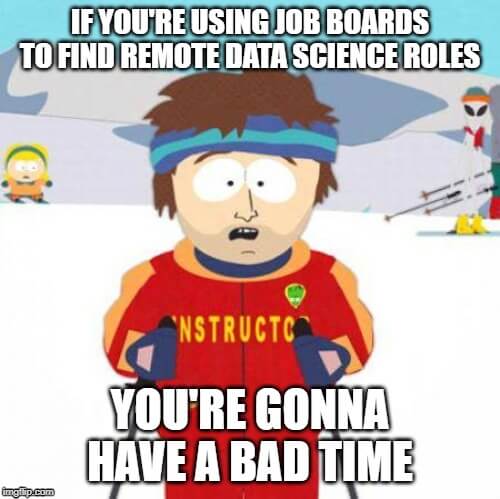Rejection is hard. Spending hours scrolling through hundreds of job posts on job boards (just to submit my resume into an abyss I rarely heard back from) prepared me quite well for the online dating world. Searching through job boards isn’t easy, nor is it ideal. If you want to maximize your chances on job boards, use our free data science resume examples and guide.
Now that I get to spend some time writing articles on topics I find interesting, I wanted to look under the hood and see what the deal was with job boards. I took a snapshot of data science jobs posted on Glassdoor, LinkedIn, and Indeed and came up with the answers to some of my questions (my methodology for getting the data is detailed below):
- 10 percent of companies post 66 percent of the jobs across Glassdoor, LinkedIn, and Indeed.
- Recruiting agencies post 14 percent of all job posts on these three sites.
- Glassdoor has the same number of data scientist jobs but fewer from recruiting agencies (8 percent versus 23 percent, respectively).
If you want a more curated experience, use BeamJobs to get five job recommendations each month that match exactly what you’re looking for. We have the highest coverage of companies (70 percent of companies in our system are not on any other job board), and we exclude all recruiting companies.
Which Data Science Job Board Should You Use?

The interactive chart above was created to help you understand which job board(s) you should use if you’re actively applying for a new data science job in any of the cities listed.
You want the most bang for your buck when choosing which job board to use (if any at all). You want to start with the site that has the greatest coverage of different companies and job posts that are not from recruiting agencies. I chose the metrics in the chart above to help you decide where you should go if you want to use one of the big three job boards:
- Distinct Non-Recruiting Firms: This is the total number of distinct companies on a job board that is not recruiting firms and is not on any other job board. To get the highest ROI from job boards, you want to apply broadly, and you want to start with the site that has the most unique companies. Focusing on companies that aren’t on other job boards has the big benefit of reducing the number of applicants you’re competing against. If a job is on all three sites, it’s a safe bet it will generate more applicants than a job that’s only on one of the sites.
- Non-Recruiting Firm Jobs: This one is all in the name. It’s the total number of data science job posts on a given site that are not from recruiting firms.
Power Posters Pursue Pareto Principle (or, 20% of companies post 76% of jobs)


The alliterative title for this section took me WAY too long to come up with. As I stated above, 10 percent of companies posted 66 percent of data science job openings, and 20 percent of companies posted 76 percent of the jobs across Indeed, Glassdoor, and LinkedIn. This roughly follows the Pareto Principle. I’m always surprised how frequently the 80/20 rule bears out in real life.
Now it’s time to play a game. Which non-recruiting companies posted the most data science jobs on these job boards? (Cue Jeopardy music):
- Up first, the company behind the supercomputer that demolished Ken Jennings and Brad Rutter in Jeopardy! (I promise this is my last Jeopardy reference, I’m just really excited for the “Greatest of All Time” showdown). IBM accounted for 2.2 percent of the total job posts.
- In a close second, we have Amazon at 2.0 percent of the total data science posts.
- Uber and Novartis are tied for third with 1.4 percent of the total job posts.
All of these companies paled in comparison to the total number of jobs posted by the recruiting agency Harnham. They accounted for a whopping 3.1 percent of all data science job posts on Indeed, Glassdoor, and LinkedIn.
As a side note, I wanted to mention how good Amazon is at SEO. If you Google “data science jobs” Amazon is the only company not in the hiring space to rank on the first page. They link to a page where they show they’re hiring for 250 data scientist positions! This keyword gets roughly 12,000 searches in the US each month, so they likely get a sizable number of applicants with this approach.
Recruiting Agencies Account for 14% of All Job Posts

Not all sites are created equal in this regard—23 percent of data science job posts on LinkedIn were from recruiting agencies, while for Glassdoor and Indeed, eight percent of all posts were from recruiting agencies. Keep in mind these are conservative estimates. I manually tagged companies as recruiting agencies, so I likely overlooked some.
While 23 percent of the data science job posts on LinkedIn were from recruiting agencies, the agency posts are largely concentrated in the later pages of results. For example, here’s the breakdown of the percentage of jobs from recruiting agencies by page number for LinkedIn in Boston:

Remote Data Science Jobs

It’s slim pickings for remote data science roles on LinkedIn, Glassdoor, and Indeed. I’m not sure if this is because full-time remote data science roles are just uncommon or if for some reason, companies aren’t paying to sponsor these jobs on job boards. Here are the total number of remote roles in the US for each of the job boards and for BeamJobs from non-recruiting companies:
- Indeed: 9
- LinkedIn: 11
- Glassdoor: 16
- BeamJobs: 54
You can see that our remote totals are higher than the job boards but still, there aren’t as many roles as even the smallest city we collected data for. At BeamJobs, we index jobs directly from company websites (it’s not pay-to-play) so it might just be the case that these jobs are few and far between. With that said, we’re still in the early days of our product, so our remote coverage will only improve over time.

The Best Way to Find Data Science Jobs

One of the most important lessons I learned from being a data analyst before starting BeamJobs is that data without concrete recommendations are not really that useful. Get the data, play around with it, and draw actionable conclusions from the analysis.
With that said, if I were to recommend a job board for a data scientist to use, I’d recommend Glassdoor. The user interface is pleasant, they have the lowest percentage of recruiting companies on the site, and their job coverage is solid. While all three job boards have quality issues in terms of some really bad job descriptions, anecdotally, the quality on Glassdoor seems higher.
If you’re interested in a more curated job search experience, use BeamJobs. We index thousands of data science and engineering jobs and then handpick the five each month that best fit what you’re looking for. Since there is a human on the other end, we won’t send recruiting agency jobs, and we only send roles with compelling job descriptions.
Data and Methodology

The data I’m presenting here is a snapshot in time from November 17, 2019. That is, I looked at all of the data science jobs on Glassdoor, LinkedIn, and Indeed on that day in the cities listed in the chart above. How did I get this data? The good old-fashioned way—manually.
I’ve made a lot of mistakes since I started BeamJobs, one of which was engineering too early. So rather than build a scraper for this one-off analysis, I spent about 15 hours getting all the companies hiring for data science roles.
To execute my searches, I filtered the jobs to contain the exact string “data scientist,” full-time, and within 10 miles of the city I was searching for. For remote roles, I chose the location as “remote” based in the US. I did some minor processing of company names to standardize them across sites, e.g., removing “Inc” from company names.
Once I had all the companies hiring data scientists, I looked up each company to see whether it was a recruiting agency. For the purposes of this analysis, I counted any company that was not directly hiring as a recruiting agency. Interestingly enough, there is some crossover in terms of job boards advertising on other job boards:

I then looked at the non-recruiting companies on each site to see which companies no other site had. The logic here is that if you’re going to use two job boards, you want to be sure you’re not seeing the same roles and companies on each job board. So by starting with the job board that has the highest coverage (in terms of total number of roles and total number of unique companies), you can save yourself time and effort.



